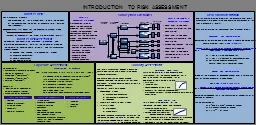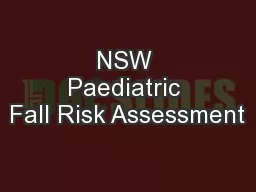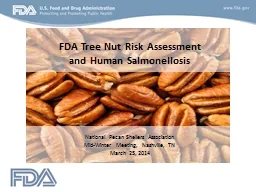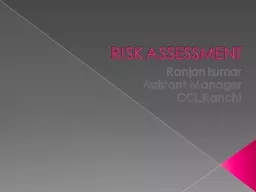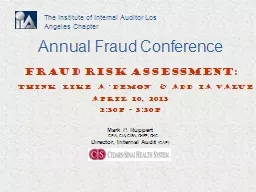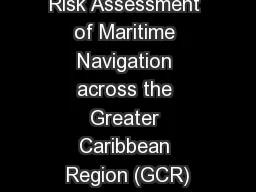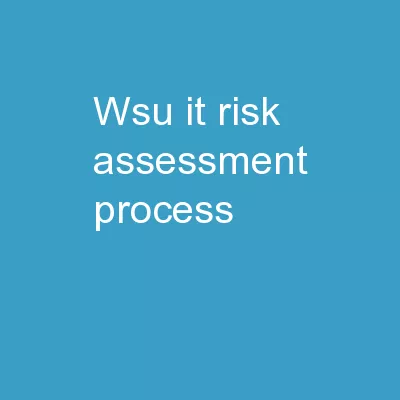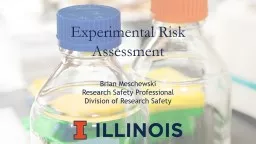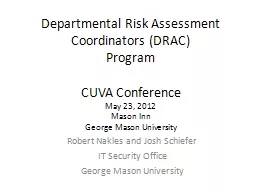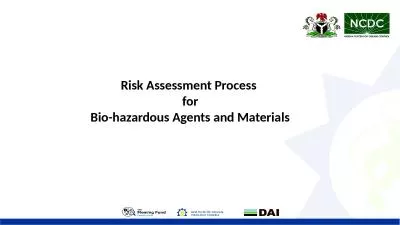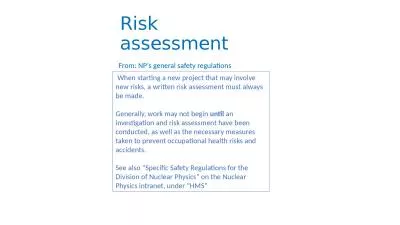PPT-INTRODUCTION TO RISK ASSESSMENT
Author : giovanna-bartolotta | Published Date : 2018-09-23
What is Risk Risk Exposure X Toxicity The magnitude of risk is proportional to both the potency of the chemical and the extent of exposure eg duration and frequency
Presentation Embed Code
Download Presentation
Download Presentation The PPT/PDF document "INTRODUCTION TO RISK ASSESSMENT" is the property of its rightful owner. Permission is granted to download and print the materials on this website for personal, non-commercial use only, and to display it on your personal computer provided you do not modify the materials and that you retain all copyright notices contained in the materials. By downloading content from our website, you accept the terms of this agreement.
INTRODUCTION TO RISK ASSESSMENT: Transcript
What is Risk Risk Exposure X Toxicity The magnitude of risk is proportional to both the potency of the chemical and the extent of exposure eg duration and frequency Exposure must first occur for the chemical to present a . Matt Frize. (Acting) Manager. Clinical & Forensic Psychologist. Community . Justice . Program. Matthew.frize@facs.nsw.gov.au . Thanks. Prof Doug Boer – . Uni. of Canberra. Prof Alex Blaszczynski – . CLINICAL EXCELLENCE COMMISSION. November 2014. Developed . by . NSW Paediatric . Falls . Resources . Committee . Paediatric Fall . Resource for NSW . The CEC in collaboration with . NSW Kids and Families have . and Human Salmonellosis. National Pecan . Shellers. Association. Mid-Winter Meeting, Nashville, TN. March 25, 2014. Why is FDA doing a risk assessment and what does this mean?. What does FDA need to know from nut processors?. Ranjan. . kumar. . Assistant Manager . CCL,Ranchi. DEFINITION. Risk Assessment: . Is a process that involves measurement of risk to determine priorities and to enable identification of appropriate level of risk treatment (used also to describe the overall process of risk management).. . Think Like a ‘Demon’ & Add IA Value. April 10, 2013. 2:30p – 3:30p. Mark P. Ruppert. . CPA, CIA, CISA, CHFP, CHC. Director, Internal Audit . (CAE). The Institute of Internal Auditor Los Angeles Chapter. . Dawn Seepersad. Student - PhD Geoinformatics. The University of the West . Indies. Introduction. This study will conduct a risk assessment of maritime navigation across the GCR. . In this presentation a case is made . March 22, 2017. Keela Ruppenthall. Information Security Analyst. Background. Structured . Assessment of . Operational Environment . Evaluate . adequacy of existing security . controls. Internal and/or external. Stephen Head | Director | Experis Finance . Agenda. Threats and Root Causes of Breaches. Financial risk / loss. Business interruption. Reputational / brand risk. Regulatory risk / requirements. Liability of Board / Management. Brian Meschewski. Research Safety Professional. Division of Research Safety. Would you cross a busy road without looking?. Why not?. What would you do to cross a road safely?. What about this road?. Hazard vs Risk. Program. CUVA . Conference. M. ay 23, 2012. Mason . Inn. George Mason University. Robert . Nakles. . and Josh Schiefer. IT Security Office. George Mason University . Presentation Overview. Purpose of the DRAC Program. kindly visit us at www.nexancourse.com. Prepare your certification exams with real time Certification Questions & Answers verified by experienced professionals! We make your certification journey easier as we provide you learning materials to help you to pass your exams from the first try. for. Bio-hazardous . Agents and Materials. Laboratory Risk Assessment Process. Reduces the worker’s and environment’s risk of exposure.. The Risk is never zero. Also call a “Hazard . Assessment.”. Generally, work may not begin . until . an investigation and risk assessment have been conducted, as well as the necessary measures taken to prevent occupational health risks and accidents. . See also “Specific Safety Regulations for the Division of Nuclear Physics” on the Nuclear Physics intranet, under “HMS”. Decision Making at Contaminated Sites: Issues and Options in Human Health Risk Assessment (RISK-3, 2015) . http://www.itrcweb.org/risk-3. . Download PowerPoint file . CLU-IN training page at . http://www.clu-in.org/conf/itrc/risk3/.
Download Document
Here is the link to download the presentation.
"INTRODUCTION TO RISK ASSESSMENT"The content belongs to its owner. You may download and print it for personal use, without modification, and keep all copyright notices. By downloading, you agree to these terms.
Related Documents

